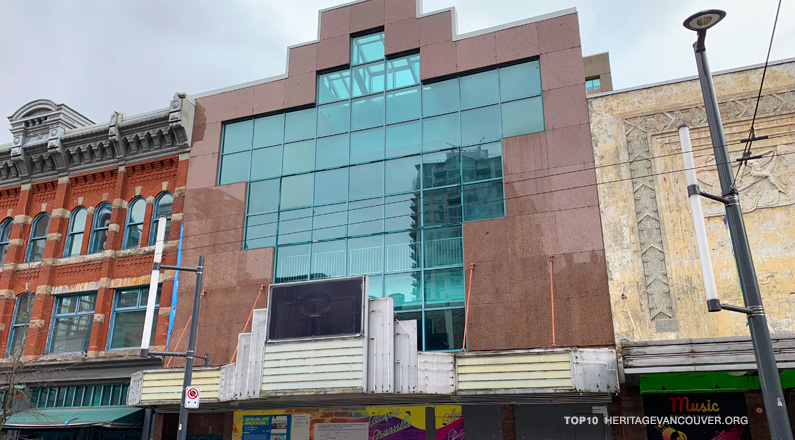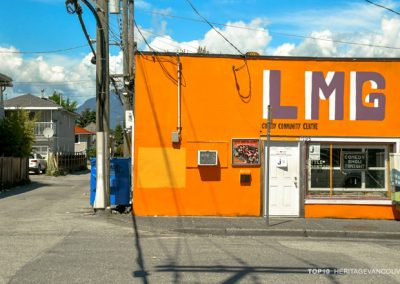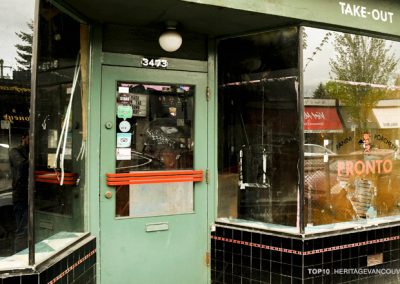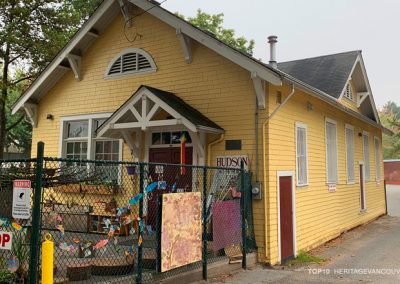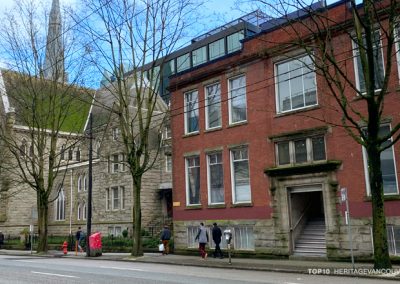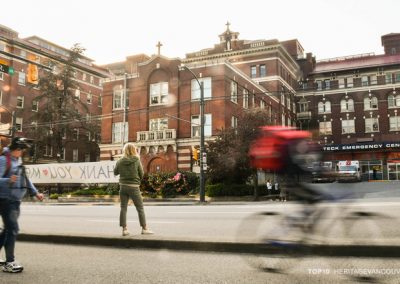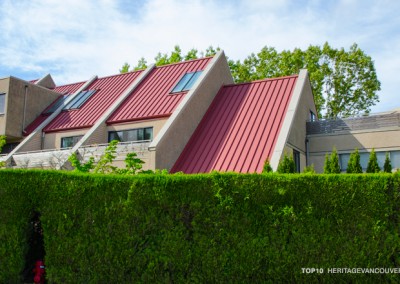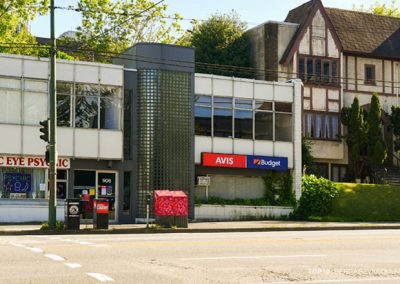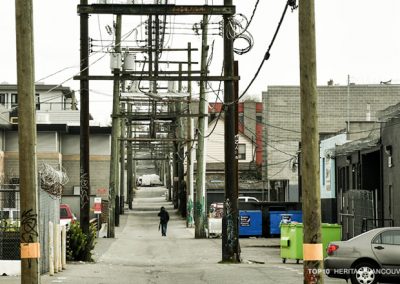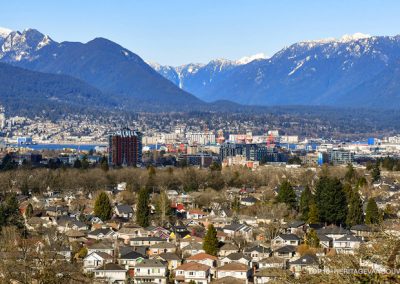Post-Modern architecture is an important part of the snapshot of how we know Vancouver’s building styles today.
Recent architecture has little official protection from the City of Vancouver; Post-modernism entirely lacks recognition or protection even though example buildings and assets are now approaching 40 years old.
While the aesthetic of post-modern art and architecture is subject to ongoing debate, lack of awareness of these assets limit our opportunities to think about what these assets express about the world around us.
Loss of examples of this era such as the granite and glass atrium portion of the Granville 7 Theatres complex at 855 Granville Street will mean that an important piece of our urban history will no longer be around to be remembered and its merits (or lack thereof) discussed.
Threat
There are few examples of post-modern architecture and interiors in Vancouver. Most recently, the post-modern atrium[1] linking the two protected heritage buildings of the Granville 7 Theatres complex was demolished. This was an excellent interior and exterior example of this style in a prominent location.
Post-modernist architecture in Vancouver generally lacks protection even though the buildings and assets are now approaching 40 years old. The demolition of the post-modern atrium of the Granville 7 Theatres complex is certainly a loss to the city’s architectural history.
More awareness and recognition of post-modern architecture would create more opportunities to think about how and what buildings express about the environment around us.
Significance
One of the goals of post-modern architecture was to see the idea of societal progress in a new and unique way that was concerned with history and context.
Post-modern thinking in architecture generally felt that the (seeming) modesty, uniformity and emphasis on functionality that characterizes modern architecture was insufficient. For many post-modern architects, there idea of architecture meant making life exciting, fun and more reflective of the cultural context that gave buildings a soul.
Some post-modern architecture simultaneously blends old and new while uniquely using different motifs, materials, shapes, and historical references.
An example of this blending of old and new can be found at the plaza of the asymmetrically shaped Park Place tower at 666 Burrard St, Vancouver. The plaza in front of the building co-exists with the Christ Church Cathedral that was built in 1894.
This balance allows for the opportunity to respect both buildings as a form of heritage that adds character and perspective to the area.
Eugenia Place is another example of pushing the boundaries of what a building is supposed to resemble. The shape of the building looks like a tree trunk and an actual tree is installed on the rooftop to allude to the history of the site as part of a forest.
Another outstanding example of this style and approach to design was the original Terry Fox memorial – a 1984 tongue in cheek triumphal arch that was replaced in 2011 with a series of bronze statues.
While the specific aesthetic quality of this arch and other post-modern assets is subject to ongoing debate, examples of this era of art and architecture provokes thinking around how they express a mood or message about society or not.
Other sites include:
- Vancouver Public Library (1995); Moshe Safdie & Associates with local partners DA Architects
- Harbour Centre (1977); WZMH Architects
- HSBC Canada Building (1986); WZMH Architects
- Crown Life Plaza (1978); project architect Peter Cardew
- The B.C. Hydro Centre (1991); Musson Cattell Mackey Partnership
- The Presidio (1989); Richard Henriquez
Position
Heritage Vancouver strongly encourages the City to update the heritage register to include important post-modern and recent architectures and interiors.
Actions
Support efforts to identify, protect and document post modern assets in the City of Vancouver.
Resources
What is Post-modernism in Architecture?
www.architecture.com/explore-architecture/postmodernism
www.architecture.org/learn/resources/architecture-dictionary/entry/postmodern/
New bold design for Empire Granville 7 theatres redevelopment in downtown Vancouver
Kenneth Chan, Daily Hive; July 12, 2018
855 Granville Street Redevelopment
Terry Fox Memorial at BC Place by Douglas Coupland
Rebecca Bollwitt, miss604.com; October 19, 2010
Empire Granville 7 Cinemas closure in November will affect film festivals
Craig Takeuchi, Georgia Straight; October 9, 2012
Official Opening of Granville 7 Theatres
Vancouver Sun, June 19, 1987 page C12
How to identify and appreciate the architecture around you
7 of Canada’s most prominent architectural styles explained
Clifton Mark, CBC; October 24, 2018
Wikipedia: Postmodern architecture in Canada (listing)
Youtube: History & the Arts – Postmodernism
Youtube: Modernism vs. Postmodernism
Rezoning application for 1500 West Georgia: Statement of Significance
City of Vancouver; Donald Luxton and Associates, Inc.
Metropolitan Vancouver’s brave new architecture
Charlie Smith, Georgia Straight; June 2, 2010
Footnotes
[1] The Granville 7 Theatres complex at 855 Granville St. consisted of three properties, the historic Palm Hotel (1894) and the Globe/Coronet Theatre (1929) tied together by a post-modern granite and glass atrium by architect David Mesbur, built-in 1987. Inside the 1987 complex is pastel granite, brass handrails, neon lights and three-storey atrium that at one time contained a massive wood sculpture by Jack Shadbolt called “art paraphrasing nature”.
